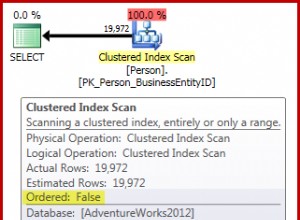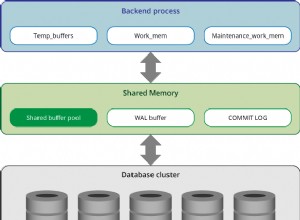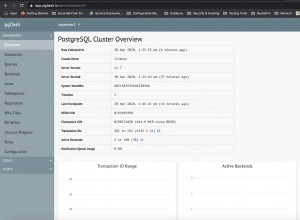Si c'est tout ce dont vous avez besoin, vous pouvez utiliser une recherche LIKE
SELECT *
FROM Table1
WHERE CELL LIKE 'AEE%';
Avec un index commençant par CELL c'est une vérification de portée, qui est rapide.
Si vos données ne ressemblent pas à cela, vous pouvez créer un path colonne qui ressemble à un chemin de répertoire et contient tous les nœuds "sur le chemin/chemin" de la racine à l'élément.
| id | CELL | parent_id | path |
|====|======|===========|==========|
| 1 | A | NULL | 1/ |
| 2 | AA | 1 | 1/2/ |
| 3 | AAA | 2 | 1/2/3/ |
| 4 | AAC | 2 | 1/2/4/ |
| 5 | AB | 1 | 1/5/ |
| 6 | AE | 1 | 1/6/ |
| 7 | AEA | 6 | 1/6/7/ |
| 8 | AEE | 6 | 1/6/8/ |
| 9 | AEEB | 8 | 1/6/8/9/ |
Pour récupérer tous les descendants de 'AE' (y compris lui-même), votre requête serait
SELECT *
FROM tree t
WHERE path LIKE '1/6/%';
ou (concaténation spécifique à MySQL)
SELECT t.*
FROM tree t
CROSS JOIN tree r -- root
WHERE r.CELL = 'AE'
AND t.path LIKE CONCAT(r.path, '%');
Résultat :
| id | CELL | parent_id | path |
|====|======|===========|==========|
| 6 | AE | 1 | 1/6/ |
| 7 | AEA | 6 | 1/6/7/ |
| 8 | AEE | 6 | 1/6/8/ |
| 9 | AEEB | 8 | 1/6/8/9/ |
Performances
J'ai créé 100 000 lignes de fausses données sur MariaDB avec le plugin de séquence en utilisant le script suivant :
drop table if exists tree;
CREATE TABLE tree (
`id` int primary key,
`CELL` varchar(50),
`parent_id` int,
`path` varchar(255),
unique index (`CELL`),
unique index (`path`)
);
DROP TRIGGER IF EXISTS `tree_after_insert`;
DELIMITER //
CREATE TRIGGER `tree_after_insert` BEFORE INSERT ON `tree` FOR EACH ROW BEGIN
if new.id = 1 then
set new.path := '1/';
else
set new.path := concat((
select path from tree where id = new.parent_id
), new.id, '/');
end if;
END//
DELIMITER ;
insert into tree
select seq as id
, conv(seq, 10, 36) as CELL
, case
when seq = 1 then null
else floor(rand(1) * (seq-1)) + 1
end as parent_id
, null as path
from seq_1_to_100000
;
DROP TRIGGER IF EXISTS `tree_after_insert`;
-- runtime ~ 4 sec.
Tests
Comptez tous les éléments sous la racine :
SELECT count(*)
FROM tree t
CROSS JOIN tree r -- root
WHERE r.CELL = '1'
AND t.path LIKE CONCAT(r.path, '%');
-- result: 100000
-- runtime: ~ 30 ms
Obtenir des éléments de sous-arborescence sous un nœud spécifique :
SELECT t.*
FROM tree t
CROSS JOIN tree r -- root
WHERE r.CELL = '3B0'
AND t.path LIKE CONCAT(r.path, '%');
-- runtime: ~ 30 ms
Résultat :
| id | CELL | parent_id | path |
|=======|======|===========|=====================================|
| 4284 | 3B0 | 614 | 1/4/11/14/614/4284/ |
| 6560 | 528 | 4284 | 1/4/11/14/614/4284/6560/ |
| 8054 | 67Q | 6560 | 1/4/11/14/614/4284/6560/8054/ |
| 14358 | B2U | 6560 | 1/4/11/14/614/4284/6560/14358/ |
| 51911 | 141Z | 4284 | 1/4/11/14/614/4284/51911/ |
| 55695 | 16Z3 | 4284 | 1/4/11/14/614/4284/55695/ |
| 80172 | 1PV0 | 8054 | 1/4/11/14/614/4284/6560/8054/80172/ |
| 87101 | 1V7H | 51911 | 1/4/11/14/614/4284/51911/87101/ |
PostgreSQL
Cela fonctionne également pour PostgreSQL. Seule la syntaxe de concaténation de chaînes doit être modifiée :
SELECT t.*
FROM tree t
CROSS JOIN tree r -- root
WHERE r.CELL = 'AE'
AND t.path LIKE r.path || '%';
Comment fonctionne la recherche
Si vous regardez l'exemple de test, vous verrez que tous les chemins dans le résultat commencent par '1/4/11/14/614/4284/'. C'est le chemin de la racine du sous-arbre avec CELL='3B0' . Si le path colonne est indexée, le moteur les trouvera toutes efficacement, car l'index est trié par path . C'est comme si vous vouliez trouver tous les mots commençant par 'pol' dans un dictionnaire de 100 000 mots. Vous n'auriez pas besoin de lire tout le dictionnaire.




